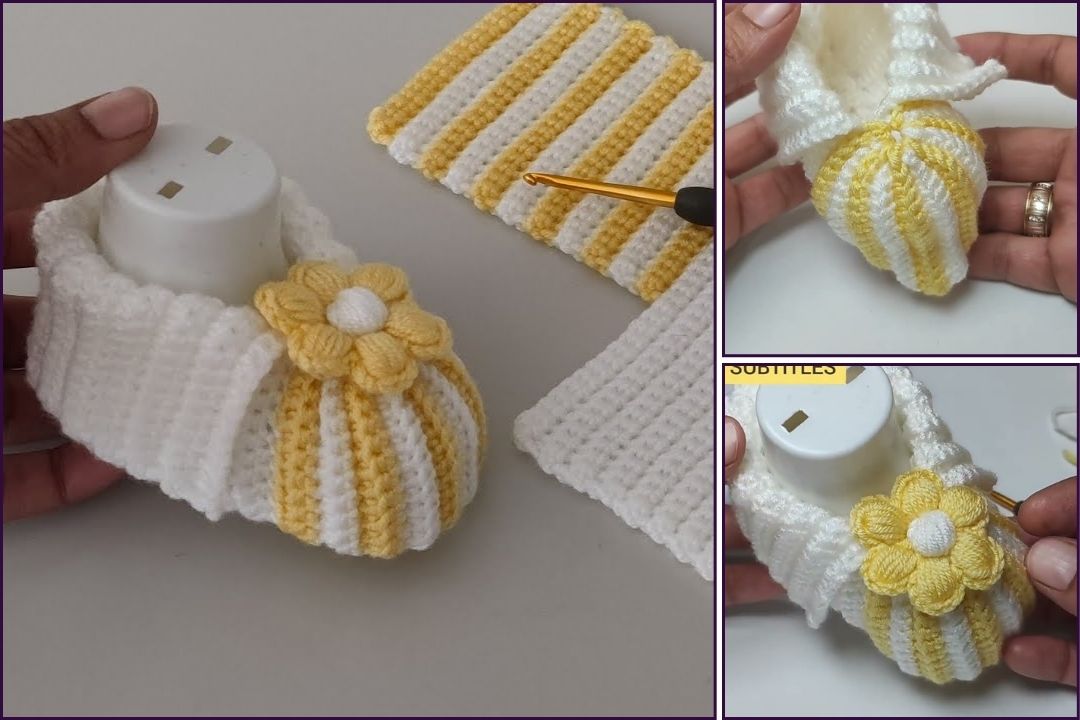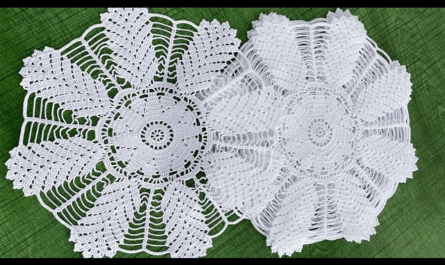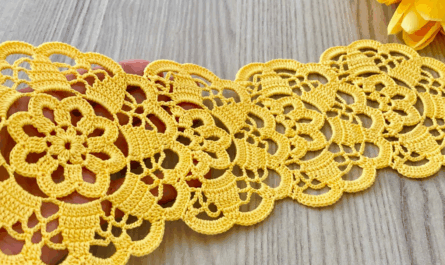Crocheting baby booties is a wonderful project for beginners and experienced crocheters alike! They’re quick to make, use minimal yarn, and are incredibly adorable. They also make perfect gifts for baby showers or new parents.
Given your location in Phnom Penh, where it’s warm, you’ll want to choose a breathable yarn. 100% cotton yarn (DK or sport weight) is an excellent choice as it’s soft, durable, easy to care for, and breathable for baby’s delicate skin in warmer climates. Bamboo and cotton blends are also great options. Avoid wool or alpaca unless it’s a very fine, breathable blend, as they can be too warm and potentially scratchy for sensitive skin.
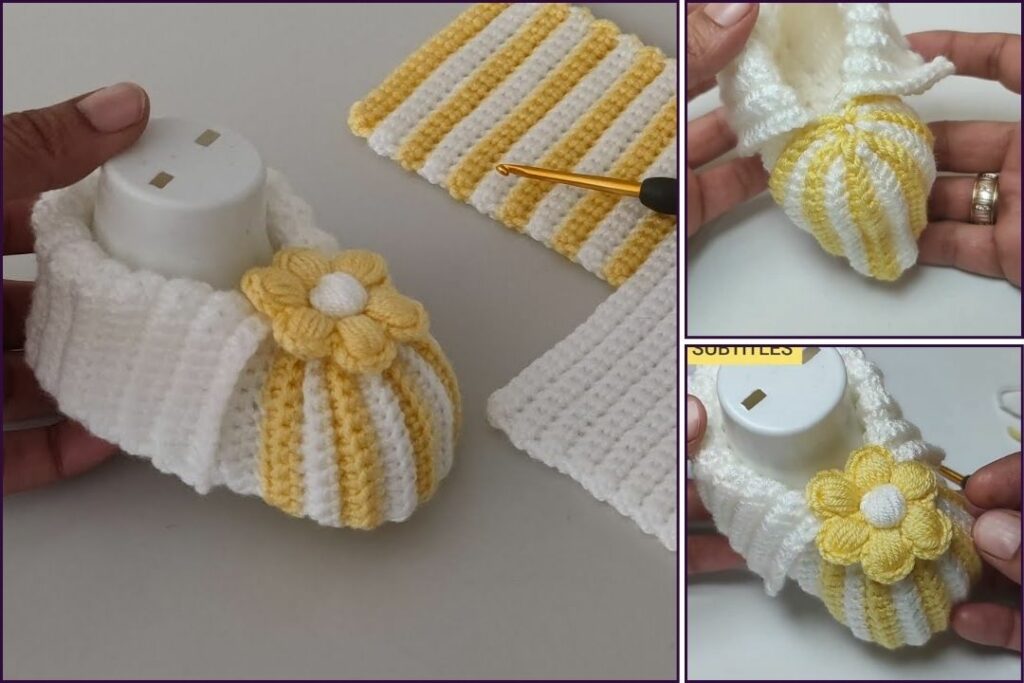
How to Crochet Baby Booties: A Beginner-Friendly Tutorial
This tutorial will guide you through creating a simple pair of baby booties, starting with the sole and then building up the sides. We’ll focus on a newborn to 3-month size as a common starting point, but I’ll provide tips for adjusting sizes.
1. Essential Materials You’ll Need
- Yarn:
- DK (Double Knitting) weight or Sport weight yarn.
- 100% Cotton or a Cotton Blend is highly recommended for breathability and softness. You’ll only need a small amount, typically less than 50g per pair.
- Choose a color you love!
- Crochet Hook:
- For DK weight yarn, a 3.5mm (US E/4) or 4.0mm (US G/6) hook is a good starting point.
- For Sport weight yarn, a 3.0mm (US C/2) or 3.5mm (US E/4) hook is usually appropriate.
- Always check your yarn label for recommended hook size, but adjust if needed to get a firm but not stiff fabric.
- Scissors: For cutting yarn.
- Yarn Needle (Tapestry Needle): Essential for weaving in ends.
- Stitch Marker (Optional but Recommended): To mark the beginning of rounds, especially when working in a spiral.
2. Basic Crochet Stitches You’ll Use
This pattern uses fundamental crochet stitches, making it perfect for beginners:
- Chain (ch): Used for the foundation.
- Slip Stitch (sl st): For joining and neatening.
- Single Crochet (sc): A short, dense stitch.
- Half Double Crochet (hdc): A medium-height stitch.
- Double Crochet (dc): A taller stitch.
- Single Crochet Two Together (sc2tog) / Decrease: Decreases the stitch count by working two stitches together.
- Half Double Crochet Two Together (hdc2tog) / Decrease: Decreases the stitch count by working two stitches together.

Understanding Baby Bootie Sizing
Baby foot sizes can vary, but here’s a general guide for the sole length:
- Newborn: 3.1 – 3.5 inches (approx. 8 – 9 cm)
- 0-3 Months: 3.5 – 3.75 inches (approx. 9 – 9.5 cm)
- 3-6 Months: 4.0 – 4.25 inches (approx. 10 – 10.8 cm)
- 6-12 Months: 4.5 – 4.75 inches (approx. 11.5 – 12 cm)
You can adjust the size of your booties by:
- Changing your hook size (larger hook = larger bootie, smaller hook = smaller bootie).
- Adjusting the initial chain length for the sole (longer chain = longer sole).
- Adding or subtracting rounds on the sole or upper.
Pro Tip for Sizing: If you know the baby’s actual foot length, crochet the sole first and compare it to the foot length. It should be just slightly shorter than the baby’s foot to allow for growth.
Crochet Baby Booties Tutorial (Newborn – 3 Months)
This pattern is worked in rounds, starting with the sole, then forming the sides and top.
Abbreviations (US Crochet Terms):
- ch: chain
- sl st: slip stitch
- sc: single crochet
- hdc: half double crochet
- dc: double crochet
- sc2tog: single crochet 2 stitches together (decrease)
- hdc2tog: half double crochet 2 stitches together (decrease)
- st(s): stitch(es)
- sk: skip

Part 1: The Sole (Work in Oval Rounds)
The sole forms the flat base of the bootie.
- Chain 11. (This will be the base for a newborn-3 month size sole. Adjust this number if you need a different size. Keep it an odd number if you want a symmetrical start).
- Round 1:
- Work 2 hdc into the 2nd ch from hook.
- Work 1 hdc in each of the next 8 chains.
- In the last chain, work 5 hdc.
- Now, working down the opposite side of the foundation chain: Work 1 hdc in each of the next 8 chains.
- Work 2 hdc into the very last stitch (which is also where you started the round).
- Join with a sl st to the top of the first hdc. (25 hdc)
- Round 2:
- Ch 1 (does not count as a stitch).
- Work 2 hdc in the first st. Work 2 hdc in the next st. (Increases at the toe end).
- Work 1 hdc in each of the next 8 sts.
- Work 2 hdc in each of the next 5 sts. (Increases around the curved toe).
- Work 1 hdc in each of the next 8 sts.
- Work 2 hdc in the next st.
- Join with a sl st to the top of the first hdc. (34 hdc)
- Round 3:
- Ch 1.
- Work 1 sc in the back loop only (BLO) of each stitch around. This creates a defined edge for the sole and makes the bootie stand up.
- Join with a sl st to the first sc. (34 sc)
- Fasten off if you want to change colors for the upper, or continue with the same yarn.
Part 2: The Upper (Sides of the Bootie)
Now we’ll build up the sides and shape the front of the bootie.
- Round 4 (Body):
- Ch 1.
- Work 1 hdc in each stitch around.
- Join with a sl st to the first hdc. (34 hdc)
- Round 5 (Start Shaping Toe):
- Ch 1.
- Work 1 hdc in each of the first 8 sts.
- Work (hdc2tog) 6 times. (This creates the toe shaping).
- Work 1 hdc in each of the remaining 8 sts.
- Join with a sl st to the first hdc. (28 hdc)
- Round 6 (Continue Shaping Toe):
- Ch 1.
- Work 1 sc in each of the first 8 sts.
- Work (sc2tog) 3 times. (Further shapes the toe).
- Work 1 sc in each of the remaining 14 sts.
- Join with a sl st to the first sc. (25 sc)

Part 3: The Ankle/Cuff
This final section creates the opening for the baby’s foot. You can make it as tall or as short as you like.
- Round 7 (Ankle):
- Ch 1.
- Work 1 hdc in each stitch around.
- Join with a sl st to the first hdc. (25 hdc)
- Round 8 (Optional Cuff/Ribbing – for a rolled or ribbed cuff):
- Ch 1.
- Work 1 sc in the back loop only (BLO) of each stitch around. This creates a nice ridge that can be turned into a fold-over cuff or forms the base for ribbing.
- Join with a sl st to the first sc. (25 sc)
- Round 9 (Optional Cuff/Ribbing):
- Ch 1.
- Work 1 sc in each stitch around (or continue BLO for more defined ribbing).
- Join with a sl st to the first sc. (25 sc)
Part 4: Finishing
- Fasten Off: Cut your yarn, leaving a tail of about 6 inches (15 cm). Yarn over your hook, pull the tail completely through the loop on your hook, and pull tight to secure.
- Weave in Ends: Use your yarn needle to carefully weave in all loose yarn tails. Go back and forth through stitches several times to secure them neatly and invisibly. This is important for both aesthetics and durability, especially for baby items.
- Make the Second Bootie: Repeat all steps to create a matching pair!

Customizing Your Baby Booties
- Color Changes: Get creative! Change colors between the sole and upper, or between different rounds of the upper. Just fasten off the old color and join the new color with a slip stitch at the start of the new round.
- Decorative Touches:
- Buttons: Sew small, flat buttons (ensure they’re securely attached and baby-safe!) onto the side or front.
- Bow/Ribbon: Thread a narrow ribbon or a crocheted chain through a row of stitches on the ankle for a decorative tie.
- Ears/Animal Faces: For more advanced crocheters, you can add small crocheted ears (like bunny or bear ears) to the top of the bootie.
- Cuff Style:
- For a simple cuff, just continue with sc or hdc for a few more rounds after Round 8.
- For a ribbed cuff, after Round 8, you can work front post/back post double crochet (fpdc/bpdc) around or work rows of single crochet in the back loop only and then sew the short edges together to form a tube that you attach to the ankle.
- Straps: You can add a simple chain strap that buttons on the side for a Mary Jane style.
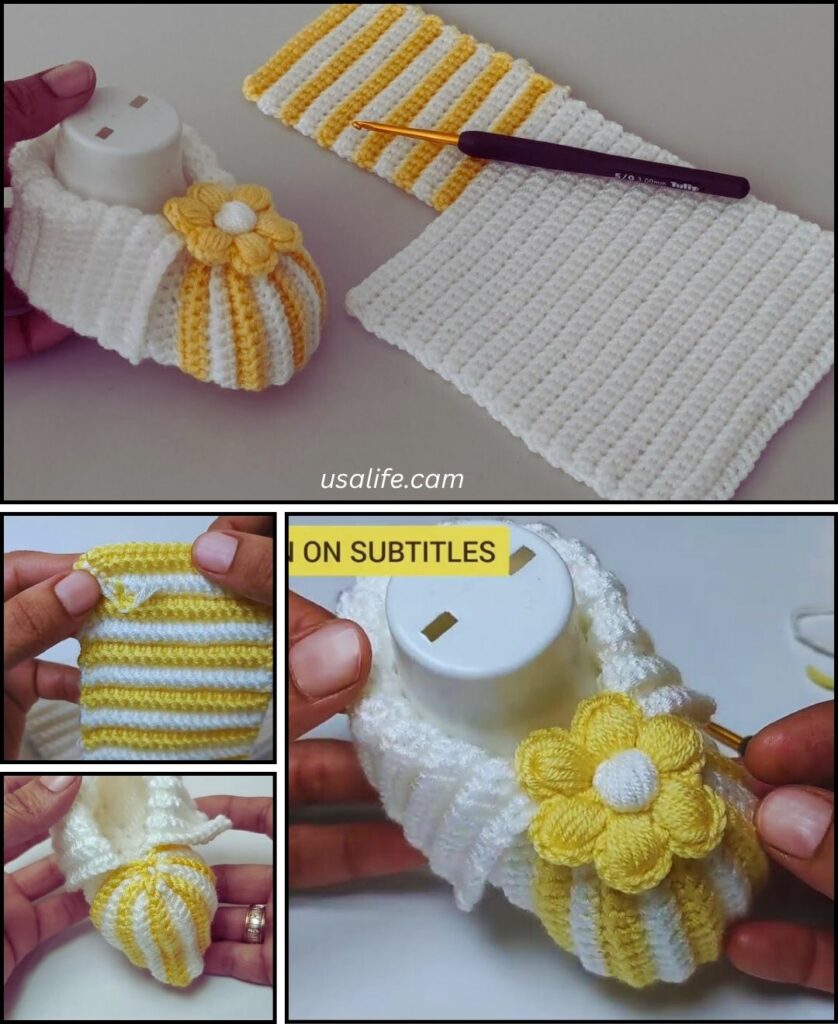
Tips for Success
- Check Your Gauge: While not critical for booties (as they stretch), consistent tension ensures both booties are the same size. If your first bootie is significantly larger or smaller than expected, adjust your hook size.
- Softness is Key: Always prioritize soft yarn that won’t irritate a baby’s delicate skin.
- Washable Yarn: Babies are messy! Choose yarn that is machine washable and dryable for easy care.
- Secure Ends: For baby items, make sure all ends are woven in very securely to prevent unraveling and potential hazards.
Now you have all the details to crochet adorable baby booties! Which color will you choose for your first pair?
